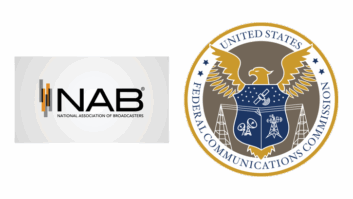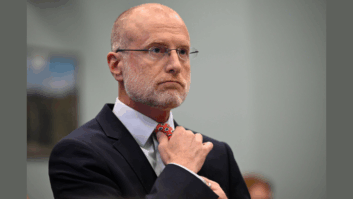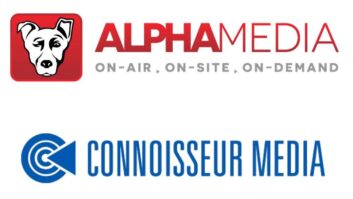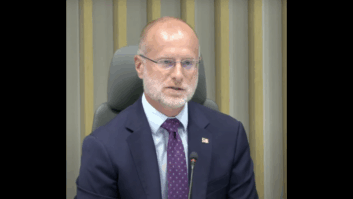A prominent advocate for the AM band is petitioning the FCC to allow stations to use all-digital transmissions in the United States.
Bryan Broadcasting Corp. on Monday filed a petition for rulemaking asking the commission to initiate a proceeding to authorize the MA3 all-digital mode of HD Radio for any AM station that chooses to do so.
Permitting such modernization would “give AM broadcasters a needed innovative tool with which to compete” without harming others in the spectrum ecosystem, it wrote.
Bryan is licensee of four AM stations, five FMs and six FM translators in Central Texas. Ben Downs is the vice president and general manager, and submitted the petition along with the company’s attorney David Oxenford of Wilkinson Barker Knauer. Downs also has served on the NAB board in the past, and he has been a vocal advocate for various regulatory steps to “revitalize” the AM band.
All HD Radio receivers in the market that have AM functionality would be able to receive such all-digital signals. But legacy AM receivers would not, which has long been a barrier to serious discussion of all-digital. Now, some observers say, the availability of FM translators for AM licensees has made something that once seemed unthinkable at least worth discussing.
There is one AM station in the country with special temporary authority to broadcast in all-digital. Hubbard’s WWFD in Frederick, Md., near the nation’s capital has been on the air since last summer. The station’s Dave Kolesar has been speaking in public about the ongoing experiment and will do so again at the upcoming NAB Show.
[Read: “All-Digital AM Radio Starts Here”]
An FCC official told Radio World this month that the commission had not received any proposals for widespread approval or adoption of all-digital AM broadcasts, so the Bryan petition appears to be the first, though this idea has been mentioned as a topic of possible interest at various times in the commission’s AM revitalization process.
Downs wrote in the petition: “In a room full of AM operators, one is likely to hear a specter of concern hanging over all-digital (especially forced conversion). Almost all such fears can be ameliorated by — as BBC proposes — making the transition to MA3 an optional election for AM licensees.
“Industry’s experimentation with an all-digital approach could be accelerated by actually allowing stations to fully switch to MA3; actual experiential knowledge by stations that elect to switch will provide economic proof-of-concept for stations that delay in order to see how others fare,” he wrote.
“Additionally, such a market-based approach will provide for customer-optimal outcomes — in markets where HD receiver penetration is insufficient among consumers, AM licensees will be incented to remain analog to maximize listener base; similarly, in markets where HD receiver penetration is high, AM licensees will be incented to serve the maximum number of consumers the best product possible by switching to MA3. And in the end, when an all-digital product goes on the air, listeners will have no reason to consider AM to be inferior.”
Downs reminded the commission of arguments that the AM band has “become so overwhelmed by interference and impulse noise that the resultant audio product is rendered unacceptable to modern listeners. Indeed, the noise floor generated by unlicensed devices impacting the AM band has been noticeable — and increasing — for years.”
He said his company has tried to quantify this rise but that “it appears studies spanning several years at specific locations have not been undertaken in the United States.” Experience in other countries, he said, suggests that the noise floor “jumped from anywhere between 10 dB and 40 dB between the 1970s and the early 2000s,” even before widespread use of later interference-contributing technologies like phone chargers and compact fluorescent lamp bulbs.
“The time has come to allow AM licensees the option to license their stations as all-digital, using the HD MA3 mode,” Downs wrote, calling for a formal rulemaking to adopt rules permitting AM licensees to have the option to go all-digital using the currently experimental MA3 mode. There may be further work needed on that mode, he wrote, but in the meantime, the audience for AM radio continues to erode. “As we have all read, some electric car manufacturers are excluding AM radio from their dashboard radios due to impulse noise. All-digital operation would be the cure for that.”
Downs said that Bryan Broadcasting has been very pleased with the audio quality of its current HD Radio hybrid signal at WTAW. “The audio broadcast is free of noise, demonstrating the proof-of-concept of a full-digital transition. To listen to WTAW in hybrid HD is to listen without the noise, pops and buzzes that plague analog AM today. However, the radio frequency mask has a larger footprint than the all-digital MA3; MA3 represents a far superior solution. And [Bryan Broadcasting] has found the hybrid mode MA1 signal to be fragile; dropouts occur in places where no obvious cause exists. By comparison, the chief engineer of WWFD has reported he must work hard to ‘break’ his stations’ MA3 signal.”
Noting that paired FM translators “critically extend the shelf life” of AM licensees and have been a welcome help, Downs wrote that “they do not fix the underlying problem of a poor listening experience when tuned to AM,” and many stations don’t have the option of using a translator, for instance in major markets.
Industry technologists have been exploring the potential implications of all-digital broadcasting for a number of years. NAB Labs (later renamed Pilot) led an all-digital HD Radio AM testing project consisting of several phases: field work to help demonstrate real-world signal coverage; lab work to establish interference behavior between stations; and allocation studies to understand the impact on FCC rules should all-digital be authorized. Companies involved included Hatfield & Dawson, Cavell Mertz, Nautel and several broadcast groups.
Pilot also conducted tests to see if all-digital would harm other occupants of the dial. Its conclusion, in brief: “Interference concerns of all-digital signals into existing analog stations should not be an impediment to the rollout of all-digital.”







